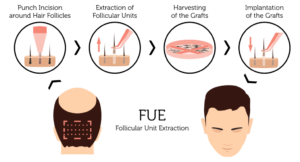Niramoy Speciality Clinic


The most important feature of a successful hair transplant involves achieving a natural-looking hairline and the right hair density, without any signs of the treatment being noticeable. Technical progress and improvements over the last decades have contributed greatly towards achieving complete naturalness. Through increasingly smaller grafts, a greater amount of hairs can now be extracted and transplanted.
In the field of hair transplantation, we distinguish between two techniques, FUT and FUE. The main difference between the two lies in the way the follicle units are extracted. In an FUT, the strip technique is used, by which a strip of the scalp with hairs on it is taken from the back of the head, with its hair follicles subsequently being extracted. Using FUE, individual follicular units are extracted directly from the scalp.
The dominant feature of both techniques is the extraction of the smallest natural hair groups, the so-called follicular units, or FUs for short. Each of these anatomical units generally consists of 1 – 4 hairs. Both techniques – FUT and FUE – make use of these natural units. The extraction method is one of the most important and decisive factors in any hair transplant. The focus is not on extracting as many grafts as possible, but on the quality of the hair roots, as they play a decisive role in determining whether the grafts take root.

It is known as strip method. Strips of superficial layers of hair bearing scalp is removed from back and sides of head. It is then dissected into fine follicular units and transplanted on to the bald area. FUT hair transplant leaves a scar on donor area.

Follicular unit extraction is advance and popular hair transplantation method. In this method no suture is given in donor area with no visible linear scar. The process involves extracting individual follicle from the back of the head or permanent hair bearing area of scalp and transplanting them onto the bald area. In fue hairs from other parts of body, i.e. – beard, body hair, moustache cane be transplanted on scalp. For minimal invasion patient can join for daily activities very quickly.